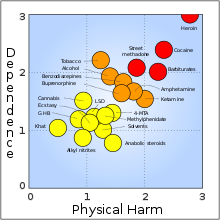
Substance abuse prevention, also known as drug abuse prevention, is a process that attempts to prevent the onset of substance use or limit the development of problems associated with using psychoactive substances. Prevention efforts may focus on the individual or their surroundings. A concept that is known as "environmental prevention" focuses on changing community conditions or policies so that the availability of substances is reduced as well as the demand.[1] Individual Substance Abuse Prevention, also known as drug abuse prevention involves numerous different sessions depending on the individual to help cease or reduce the use of substances. The time period to help a specific individual can vary based upon many aspects of an individual. The type of Prevention efforts should be based upon the individual's necessities which can also vary. Substance use prevention efforts typically focus on minors and young adults — especially between 12–35 years of age. Substances typically targeted by preventive efforts include alcohol (including binge drinking, drunkenness and driving under the influence), tobacco (including cigarettes and various forms of smokeless tobacco), marijuana, inhalants (volatile solvents including among other things glue, gasoline, aerosols, ether, fumes from correction fluid and marking pens), coke, methamphetamine, steroids, club drugs (such as MDMA), and opioids. Community advocacy against substance use is imperative due to the significant increase in opioid overdoses in the United States alone. It has been estimated that about one hundred and thirty individuals continue to lose their lives daily due to opioid overdoses alone.[2]
- ^ "Drug Prevention". www.scodc.org/tag/drug-prevention/.
- ^ "Understanding the Epidemic | Drug Overdose | CDC Injury Center". www.cdc.gov. 2019-07-24. Retrieved 2019-10-23.